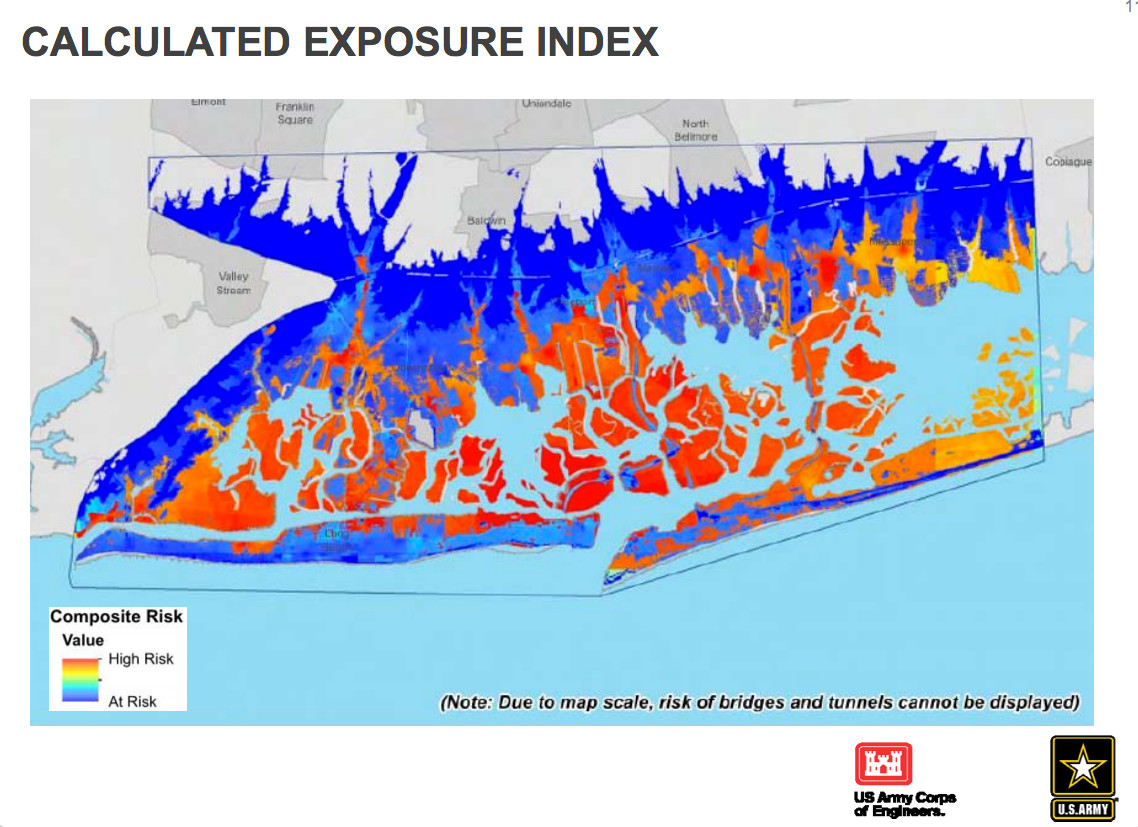Army Corps looks to protect city’s north side
Holds public meeting to discuss Back Bays study and mitigation
As the fifth anniversary of Hurricane Sandy nears, local and federal officials who are all too familiar with its destruction are pushing a plan to protect communities like Long Beach that are at high risk along the bay shorelines of Nassau County.
More than 60 people gathered at City Hall on Sept. 18 for a meeting hosted by the U.S. Army Corps of Engineers, the New York State Department of Environmental Conservation and Nassau County to learn about the Back Bays Coastal Storm Risk Management and Feasibility Study, which began in April to investigate potential ways to reduce the risk of coastal erosion, wave action, storm surge, flooding and severe winds, all of which were seen during Sandy.
Long Beach residents who live along the bay suffered some of the worst damage in the storm, which caused record-breaking flooding, especially in the Canals and the West End. In some areas, the ocean met the bay, much of it sewage-tinged floodwater that inundated streets and homes and damaged infrastructure along Reynolds Channel.
Covering about 200 miles of back bay shoreline in Nassau and Suffolk, the study, which is expected to be completed in three years, calls for building structures like floodwalls and levees to protect against storms and flooding.
The meeting was held on the same day that Hurricane Jose threatened the South Shore, and officials and residents alike expressed a sense of urgency to move storm-protection projects forward quickly.
“We’re in the midst of hurricane season, and it’s a little bit more active than normal,” City Council Vice President Anthony Eramo said. “We must do everything we can to be prepared.”
Study calls for protecting high-risk areas
After Sandy, the Army Corps identified Nassau County’s back bays as one of nine high-risk areas along the Northeast coast. Since May, Danielle Tommaso, an Army Corps project planner, said, the agency has gathered information and feedback from local leaders and residents.
In Long Beach and other communities like Freeport, Tommaso said, the corps is considering building floodwalls, bulkheads, levees, storm surge barriers and dunes, which would “stop the flooding in its track.”
The study also calls for potentially elevating homes, relocating families, flood-proofing buildings and changing zoning codes, as well as creating marshes, oyster reefs and wetlands, among other protective measures.
“There’s been a paradigm shift within the corps to think about holistic, sustainable solutions and not just, ‘Let’s build a wall here and solve the problem,’” Tommaso said. “It’s more like, ‘Let’s look at the entire system and see what makes sense for everybody,’ and see what makes sense not only for people, but the environment. We’re looking at everything in a system’s context.”
Cliff Jones, chief of the Army Corps’ New York District planning division, said that the study is the first step in a larger plan to protect the South Shore. Once completed, it would require congressional approval and additional funding to begin construction.
City and state officials have called for a comprehensive approach to protecting Long Beach from future storms, and said that a long-term resiliency plan for the north side of the city would complement a long-awaited coastal protection project now under way on the beach that the Army Corps began in the spring, which includes a system of dunes and jetties (see accompanying story).
“We have aggressively advocated for comprehensive regional protection, and we wholeheartedly support this study,” City Manager Jack Schnirman said. “A project of this magnitude will require federal funding, and we need to work now to ensure the implementation money will be available once the project is ready to begin.”
Residents say bayside protection is urgent
The city recently informed residents that a $12.4 million state-funded plan to build bulkheads along the north side of the city, a top priority identified by Long Beach’s Community Reconstruction Program planning committee after Sandy, would now only cover public property along Reynolds Channel. A consulting firm provided by the state underestimated the amount of bulkheading needed to protect homes along the north shore.
A number of residents said that that project would not provide adequate protection unless residents opted to rebuild their private bulkheads as well.
John Bendo, an independent candidate running for City Council and a member of the CRP committee, expressed concerns about the potential funding for protective measures proposed in the Army Corps study and described the city’s recent bulkhead project as a “hard-learned lesson.” He also asked how long it would take to begin construction.
“I realize that for government projects, funding is erratic,” Bendo said. “Will any of us be alive to see a completed Back Bays protection project?”
Freeport Mayor Robert Kennedy said that U.S. Sen. Charles Schumer had secured $1.5 million in federal money for the study, while New York state supplied $1 million, and Nassau County, $5,000.
But there’s still a need for more federal money needed to complete the study, Tommaso explained.
“We’re trying to get a handle on the amount of federal funding that we may receive for the next few federal fiscal years, to make sure we have all the money we need to complete the study,” she said.

 45.0°,
Mostly Cloudy
45.0°,
Mostly Cloudy 





